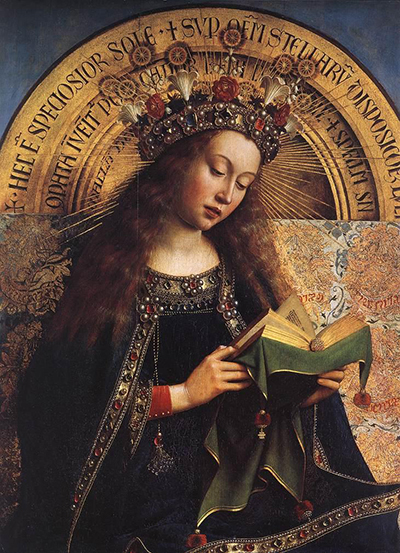The Virgin Mary is a key panel in The Ghent Altarpiece, sitting in the central, upper column, just besides the central God the Father painting. The overall ensemble remains on display in St Bavo's Cathedral, Ghent, Belgium.
This pretty portrait is amongst the most memorable elements from this series of panel paintings. You will find some incredible detail within this painting which underlines the attention taken by Van Eyck, going to extreme lengths in order to ensure such high quality work. Some of the elements to appreciate from larger images of this painting include the lettering around the top of the composition, along with elaborate jewellery and clothing flourishes. When viewing something such as this artwork, it is easy to understand why Jan van Eyck would need to call upon the aid of assistants and other family members in order to complete some of his projects, because of the level of detail that he was intent on adding. It also helps to explain why his career oeuvre was relatively small by the end of his lifetime, with just a few paintings attributed to his hand.
The Madonna is captured here looking particularly young and beautiful in this flattering depiction. She reads in a relaxed pose, whilst dressed in some stunning attire. Her robe is a deep blue colour, almost black, whilst some decorative gold stiching around the hem. Each and every jewel is carefully crafted by the artist who allows light to deflect from each one, bringing a vivid nature to this piece. Mary herself is specifically reading from a small prayer book and so her calmness is also joined by wholesome knowledge as she underlines her strong moral character from which the rest of us can presumably learn. Artists over the centuries have depicted the Madonna in all manner of different ways, with her appearance being most common within the 15th to 16th centuries, when religion and art was pretty much inseparable.
A further note of interest would be the patterned background which is one of the hallmarks of this talented and thorough artist. He could reproduce intricate crafts such as embroidery or tiled floors on the canvas in ways that had not been seen before and this allowed his work to stand out as something truly special. He would research each of these touches in great detail in order to ensure accuracy. He also had to carefully consider colour as oils were not as easy to acquire as they are today and so resources needed to be considered. The crown itself features several different flower types, adding a feminine touch to this piece. Specifically there are lilies, columbines and lily-of-the-valley which each hold a symbolic value besides their aesthetic role.




